Impact of Inflation Rate on Gross Revenue of Australian Companies
VerifiedAdded on 2023/06/07
|37
|5646
|316
Report
AI Summary
This professional project report evaluates the impact of the inflation rate on the gross revenue of companies in Australia. The research explores the relationship between inflation and company performance, considering factors such as price stability and consumption. The study examines the impact of inflation on the cost of raw materials and other expenses, and reviews the theoretical and practical aspects of this relationship. The report includes an introduction, literature review, research methodology (including research philosophy, approach, and design), findings and analysis, and a conclusion. The findings suggest a negative correlation between inflation and gross revenue, with companies generally preferring low and stable inflation rates. The report also considers the implications of these findings and provides recommendations based on the analysis.
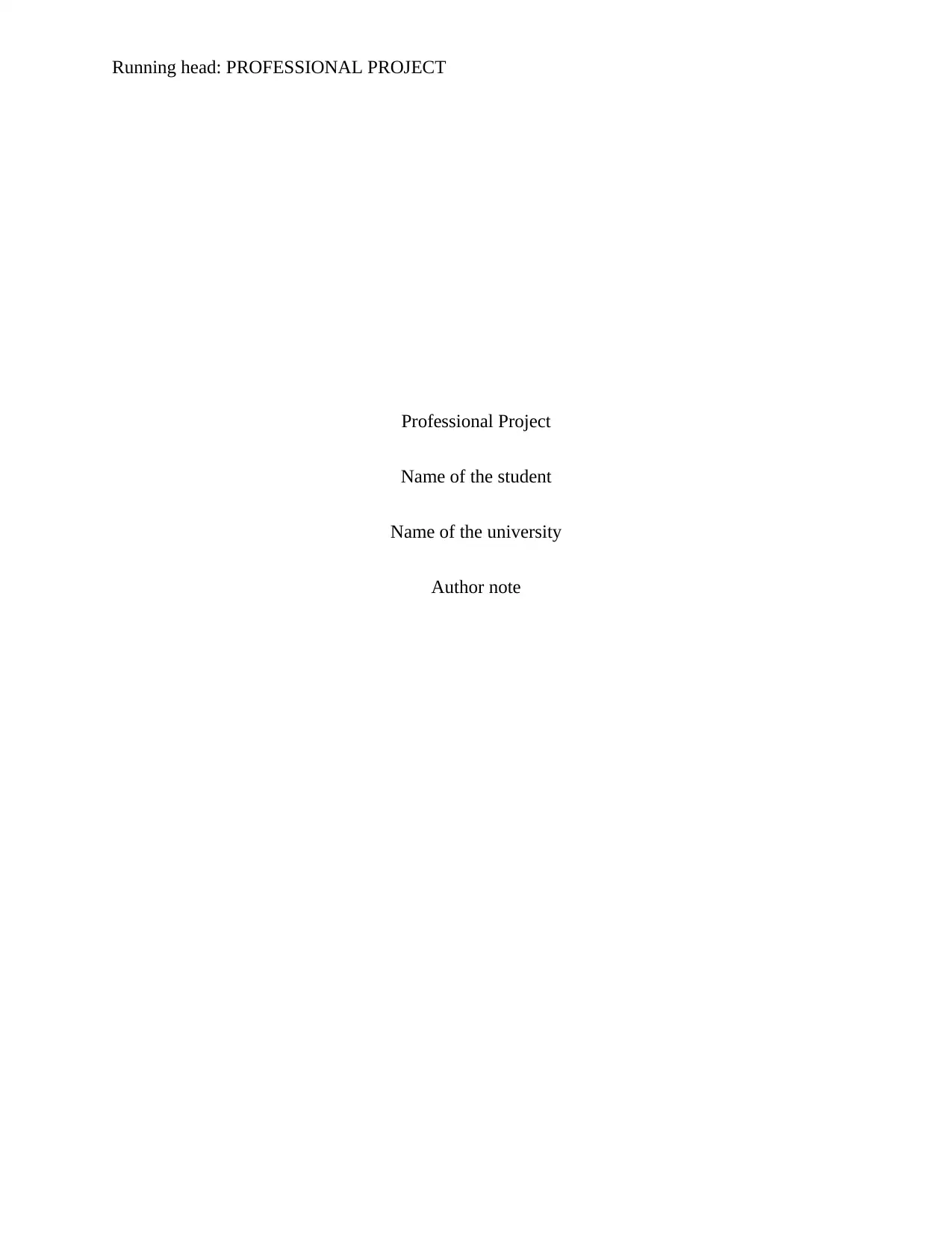
Running head: PROFESSIONAL PROJECT
Professional Project
Name of the student
Name of the university
Author note
Professional Project
Name of the student
Name of the university
Author note
Paraphrase This Document
Need a fresh take? Get an instant paraphrase of this document with our AI Paraphraser

1PROFESSIONAL PROJECT
Executive Summary
This report has analyzed the impact of inflation rate on gross revenue of companies belonging to
different sector in Australia. The findings of the study shows that there is negative impact
between the inflation rate and gross revenue of companies. Companies prefer to inflation rate to
be low and stable but in developed countries like Australia, moderate inflation is required for
increasing economic growth and the results have been similar to the expectation.
Executive Summary
This report has analyzed the impact of inflation rate on gross revenue of companies belonging to
different sector in Australia. The findings of the study shows that there is negative impact
between the inflation rate and gross revenue of companies. Companies prefer to inflation rate to
be low and stable but in developed countries like Australia, moderate inflation is required for
increasing economic growth and the results have been similar to the expectation.
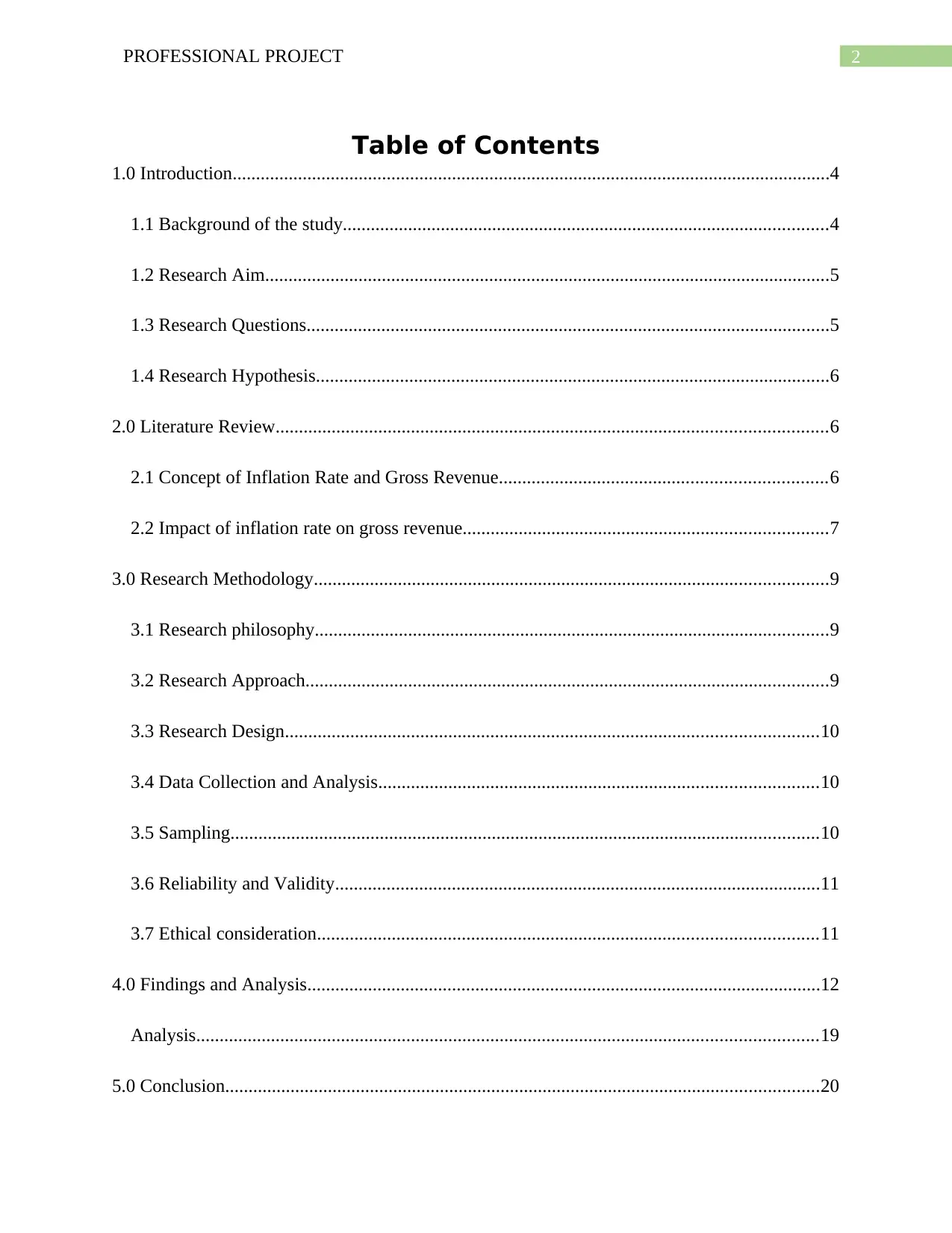
2PROFESSIONAL PROJECT
Table of Contents
1.0 Introduction................................................................................................................................4
1.1 Background of the study........................................................................................................4
1.2 Research Aim.........................................................................................................................5
1.3 Research Questions................................................................................................................5
1.4 Research Hypothesis..............................................................................................................6
2.0 Literature Review......................................................................................................................6
2.1 Concept of Inflation Rate and Gross Revenue......................................................................6
2.2 Impact of inflation rate on gross revenue..............................................................................7
3.0 Research Methodology..............................................................................................................9
3.1 Research philosophy..............................................................................................................9
3.2 Research Approach................................................................................................................9
3.3 Research Design..................................................................................................................10
3.4 Data Collection and Analysis..............................................................................................10
3.5 Sampling..............................................................................................................................10
3.6 Reliability and Validity........................................................................................................11
3.7 Ethical consideration...........................................................................................................11
4.0 Findings and Analysis..............................................................................................................12
Analysis.....................................................................................................................................19
5.0 Conclusion...............................................................................................................................20
Table of Contents
1.0 Introduction................................................................................................................................4
1.1 Background of the study........................................................................................................4
1.2 Research Aim.........................................................................................................................5
1.3 Research Questions................................................................................................................5
1.4 Research Hypothesis..............................................................................................................6
2.0 Literature Review......................................................................................................................6
2.1 Concept of Inflation Rate and Gross Revenue......................................................................6
2.2 Impact of inflation rate on gross revenue..............................................................................7
3.0 Research Methodology..............................................................................................................9
3.1 Research philosophy..............................................................................................................9
3.2 Research Approach................................................................................................................9
3.3 Research Design..................................................................................................................10
3.4 Data Collection and Analysis..............................................................................................10
3.5 Sampling..............................................................................................................................10
3.6 Reliability and Validity........................................................................................................11
3.7 Ethical consideration...........................................................................................................11
4.0 Findings and Analysis..............................................................................................................12
Analysis.....................................................................................................................................19
5.0 Conclusion...............................................................................................................................20
⊘ This is a preview!⊘
Do you want full access?
Subscribe today to unlock all pages.

Trusted by 1+ million students worldwide
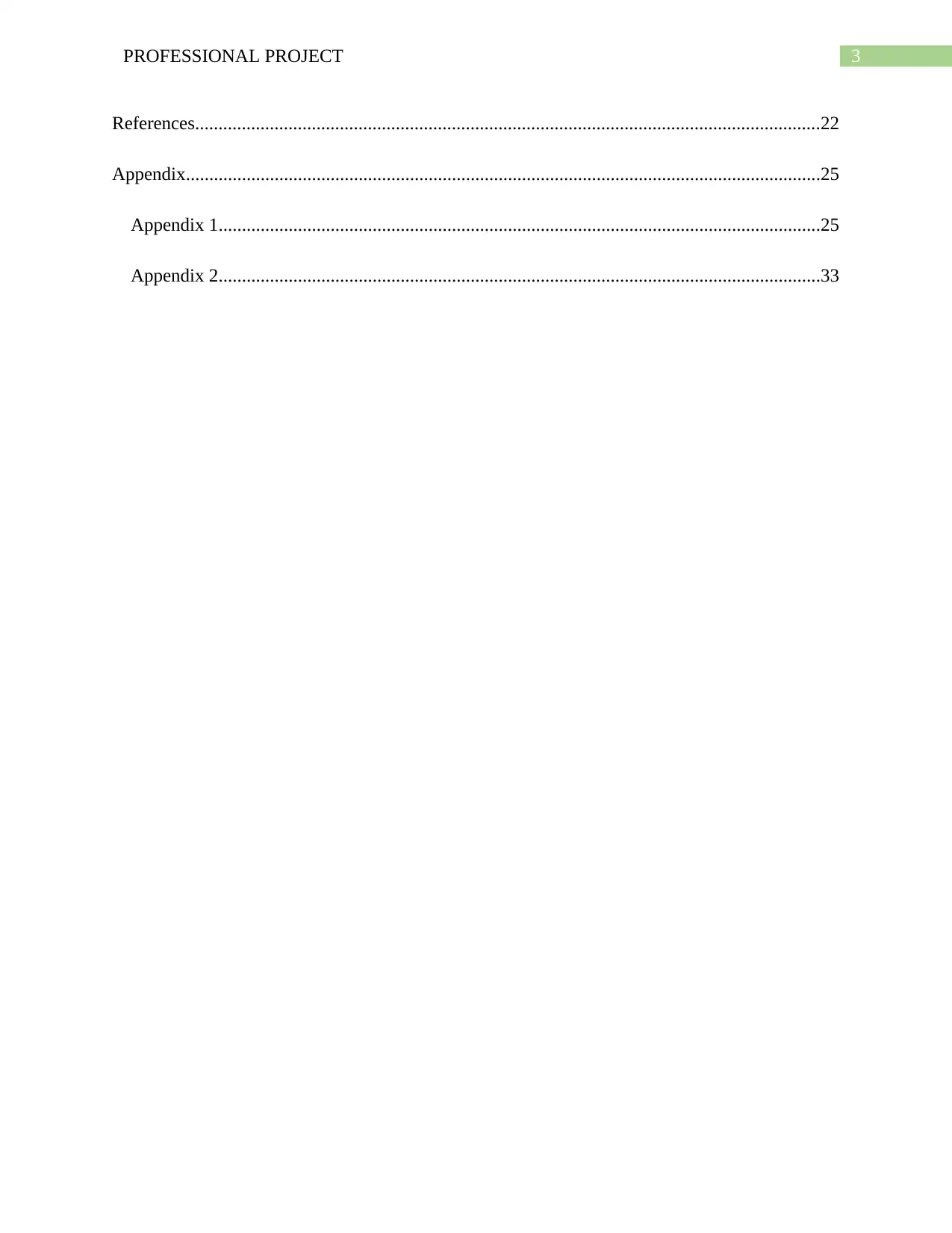
3PROFESSIONAL PROJECT
References......................................................................................................................................22
Appendix........................................................................................................................................25
Appendix 1.................................................................................................................................25
Appendix 2.................................................................................................................................33
References......................................................................................................................................22
Appendix........................................................................................................................................25
Appendix 1.................................................................................................................................25
Appendix 2.................................................................................................................................33
Paraphrase This Document
Need a fresh take? Get an instant paraphrase of this document with our AI Paraphraser

4PROFESSIONAL PROJECT
Topic: Impact of inflation rate on gross revenue of companies in Australia
1.0 Introduction
The purpose of this report is to evaluate the impact of inflation rate on the gross revenue
of the companies Australia. The performance of an economy is dependent of different factors
such as national reserve, output, per capita income, investment, exchange rate, interest rate and
price stability. Price stability or in other terms inflation rate is among top priorities for both
developed and developing nations. The knowledge gained in this study are essential for
understanding the market economies in developed countries like Australia. Price stability has a
profound impact of the operations of the companies as it increases the cost of raw materials and
other necessary costs.
1.1 Background of the study
The theoretical aspect of the relationship between Gross Domestic product and inflation
rate is negative where the increase in inflation rate means that there will be decrease in the
consumption. In theoretical terms, GDP= Consumption + Investment + Government
Expenditure + Net Exports (Exports – Imports) where if there is increase in inflation rate, price
stability decreases due to the increase in the prices of the consumer goods (Gay, 2016). This
means that there will be significant decrease in the consumption due to the increase in the prices.
This means that the gross revenue of the companies in Australia will be highly affected due to
the decrease in consumption of the goods. This implies that a higher GDP signifies higher
revenue generation from the companies in Australia as they directly contribute to the GDP.
In practical scenarios and economies experience high inflation rate when there is growth
or increase in the Gross Domestic product. Australia has a steady low inflation rate in the past
Topic: Impact of inflation rate on gross revenue of companies in Australia
1.0 Introduction
The purpose of this report is to evaluate the impact of inflation rate on the gross revenue
of the companies Australia. The performance of an economy is dependent of different factors
such as national reserve, output, per capita income, investment, exchange rate, interest rate and
price stability. Price stability or in other terms inflation rate is among top priorities for both
developed and developing nations. The knowledge gained in this study are essential for
understanding the market economies in developed countries like Australia. Price stability has a
profound impact of the operations of the companies as it increases the cost of raw materials and
other necessary costs.
1.1 Background of the study
The theoretical aspect of the relationship between Gross Domestic product and inflation
rate is negative where the increase in inflation rate means that there will be decrease in the
consumption. In theoretical terms, GDP= Consumption + Investment + Government
Expenditure + Net Exports (Exports – Imports) where if there is increase in inflation rate, price
stability decreases due to the increase in the prices of the consumer goods (Gay, 2016). This
means that there will be significant decrease in the consumption due to the increase in the prices.
This means that the gross revenue of the companies in Australia will be highly affected due to
the decrease in consumption of the goods. This implies that a higher GDP signifies higher
revenue generation from the companies in Australia as they directly contribute to the GDP.
In practical scenarios and economies experience high inflation rate when there is growth
or increase in the Gross Domestic product. Australia has a steady low inflation rate in the past
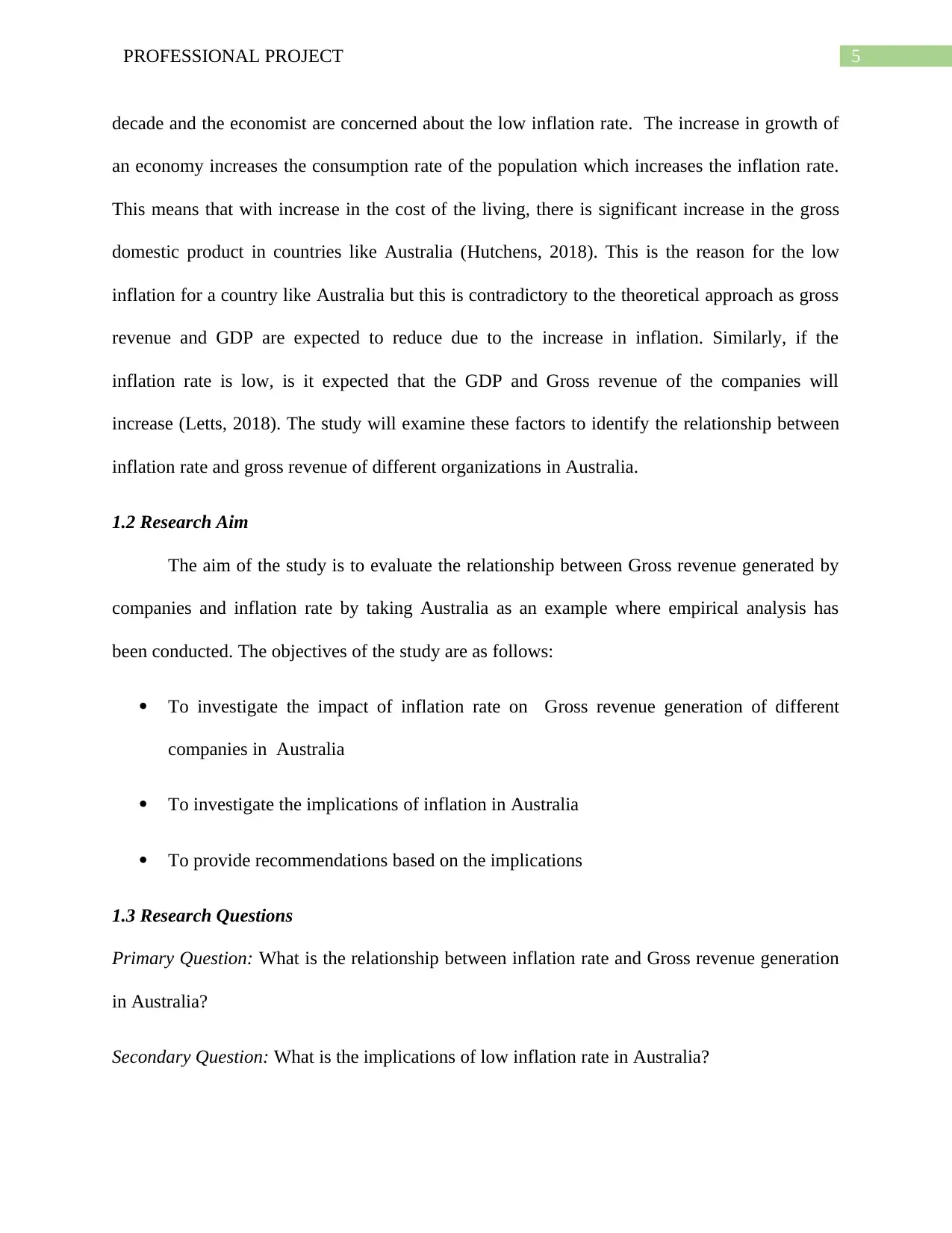
5PROFESSIONAL PROJECT
decade and the economist are concerned about the low inflation rate. The increase in growth of
an economy increases the consumption rate of the population which increases the inflation rate.
This means that with increase in the cost of the living, there is significant increase in the gross
domestic product in countries like Australia (Hutchens, 2018). This is the reason for the low
inflation for a country like Australia but this is contradictory to the theoretical approach as gross
revenue and GDP are expected to reduce due to the increase in inflation. Similarly, if the
inflation rate is low, is it expected that the GDP and Gross revenue of the companies will
increase (Letts, 2018). The study will examine these factors to identify the relationship between
inflation rate and gross revenue of different organizations in Australia.
1.2 Research Aim
The aim of the study is to evaluate the relationship between Gross revenue generated by
companies and inflation rate by taking Australia as an example where empirical analysis has
been conducted. The objectives of the study are as follows:
To investigate the impact of inflation rate on Gross revenue generation of different
companies in Australia
To investigate the implications of inflation in Australia
To provide recommendations based on the implications
1.3 Research Questions
Primary Question: What is the relationship between inflation rate and Gross revenue generation
in Australia?
Secondary Question: What is the implications of low inflation rate in Australia?
decade and the economist are concerned about the low inflation rate. The increase in growth of
an economy increases the consumption rate of the population which increases the inflation rate.
This means that with increase in the cost of the living, there is significant increase in the gross
domestic product in countries like Australia (Hutchens, 2018). This is the reason for the low
inflation for a country like Australia but this is contradictory to the theoretical approach as gross
revenue and GDP are expected to reduce due to the increase in inflation. Similarly, if the
inflation rate is low, is it expected that the GDP and Gross revenue of the companies will
increase (Letts, 2018). The study will examine these factors to identify the relationship between
inflation rate and gross revenue of different organizations in Australia.
1.2 Research Aim
The aim of the study is to evaluate the relationship between Gross revenue generated by
companies and inflation rate by taking Australia as an example where empirical analysis has
been conducted. The objectives of the study are as follows:
To investigate the impact of inflation rate on Gross revenue generation of different
companies in Australia
To investigate the implications of inflation in Australia
To provide recommendations based on the implications
1.3 Research Questions
Primary Question: What is the relationship between inflation rate and Gross revenue generation
in Australia?
Secondary Question: What is the implications of low inflation rate in Australia?
⊘ This is a preview!⊘
Do you want full access?
Subscribe today to unlock all pages.

Trusted by 1+ million students worldwide

6PROFESSIONAL PROJECT
1.4 Research Hypothesis
H0: There is negative between inflation rate and gross revenue generation for the companies in
Australia
H1: There is positive relationship between inflation rate and gross revenue generation for the
companies in Australia
2.0 Literature Review
2.1 Concept of Inflation Rate and Gross Revenue
Akhmetshin and Osadchy, (2015) revealed that inflation can be explained as a
considerable increase in the price level of goods and services within an economy over a specific
time period. A major measure of the price inflation is observed to be the inflation rate, the yearly
percentage change within the general price index that is basically the customer price index.
Egger and Wamser, (2015) added that with increasing inflation rates it is observed that inflation
is increasing with time because of which the spending within the economic needs requires being
tempered in order to offer stability that is highly beneficial to companies in making profits. It has
been observed that with increasing prices of commodities, food and energy along with several
other services and goods the overall economy is observed to be impacted. Hebous and Ruf,
(2017) also elaborated that controlled inflation can serve as a healthy sign for the overall
economy as larger organizations are generally positioned better in dealing with adverse impacts
of inflation as it can be addressed by savings gathered from economies of scale. Moreover,
researchers namely, Hoffmann and Schnabl, (2016) that revenue serves as the form of income
which is attained by companies through sale of its services or goods. Moreover, gross revenue is
also explained as the revenue that is attained by companies through subtracting expenses
associated with attaining revenue like wages, overhead, production costs, taxes and commission.
1.4 Research Hypothesis
H0: There is negative between inflation rate and gross revenue generation for the companies in
Australia
H1: There is positive relationship between inflation rate and gross revenue generation for the
companies in Australia
2.0 Literature Review
2.1 Concept of Inflation Rate and Gross Revenue
Akhmetshin and Osadchy, (2015) revealed that inflation can be explained as a
considerable increase in the price level of goods and services within an economy over a specific
time period. A major measure of the price inflation is observed to be the inflation rate, the yearly
percentage change within the general price index that is basically the customer price index.
Egger and Wamser, (2015) added that with increasing inflation rates it is observed that inflation
is increasing with time because of which the spending within the economic needs requires being
tempered in order to offer stability that is highly beneficial to companies in making profits. It has
been observed that with increasing prices of commodities, food and energy along with several
other services and goods the overall economy is observed to be impacted. Hebous and Ruf,
(2017) also elaborated that controlled inflation can serve as a healthy sign for the overall
economy as larger organizations are generally positioned better in dealing with adverse impacts
of inflation as it can be addressed by savings gathered from economies of scale. Moreover,
researchers namely, Hoffmann and Schnabl, (2016) that revenue serves as the form of income
which is attained by companies through sale of its services or goods. Moreover, gross revenue is
also explained as the revenue that is attained by companies through subtracting expenses
associated with attaining revenue like wages, overhead, production costs, taxes and commission.
Paraphrase This Document
Need a fresh take? Get an instant paraphrase of this document with our AI Paraphraser
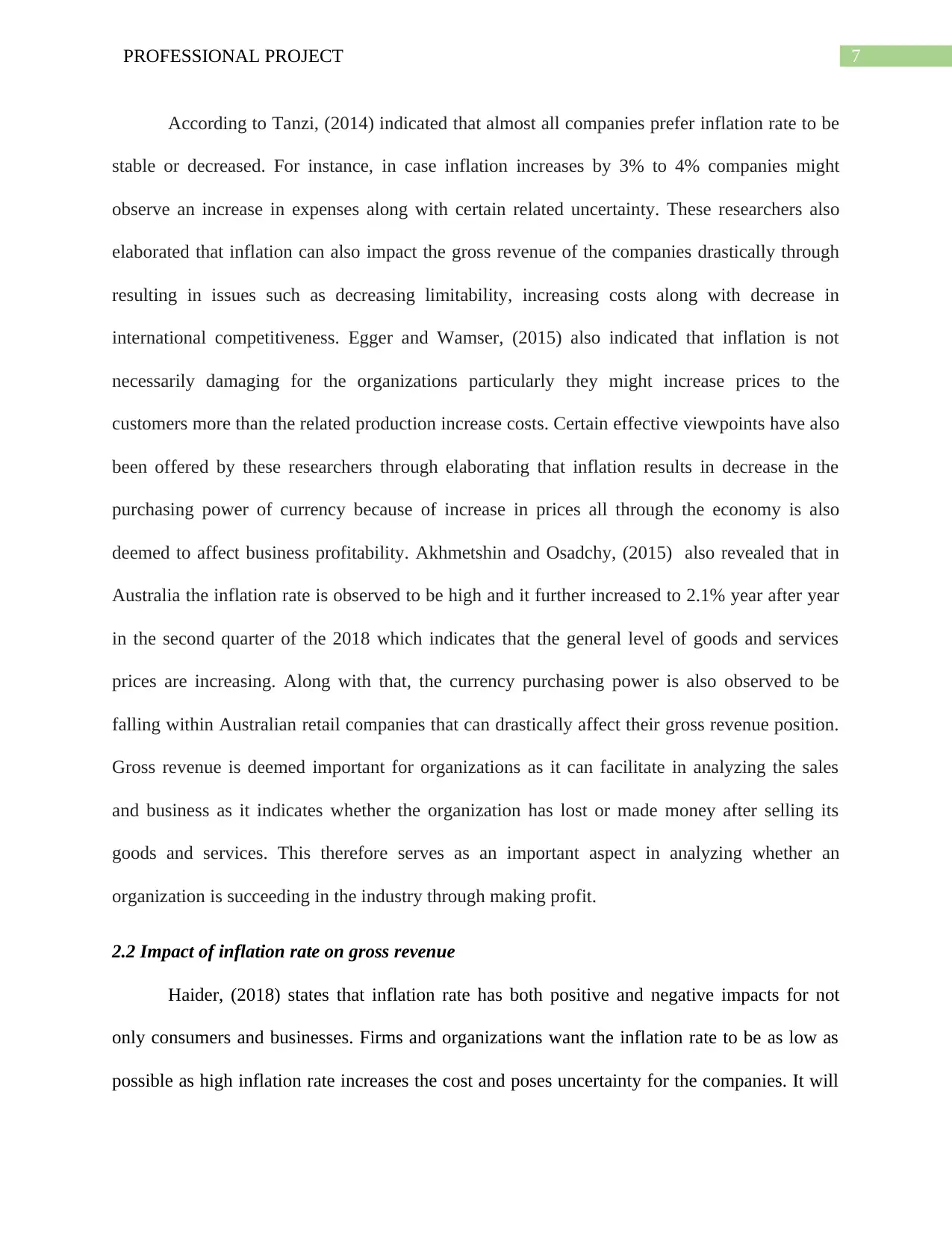
7PROFESSIONAL PROJECT
According to Tanzi, (2014) indicated that almost all companies prefer inflation rate to be
stable or decreased. For instance, in case inflation increases by 3% to 4% companies might
observe an increase in expenses along with certain related uncertainty. These researchers also
elaborated that inflation can also impact the gross revenue of the companies drastically through
resulting in issues such as decreasing limitability, increasing costs along with decrease in
international competitiveness. Egger and Wamser, (2015) also indicated that inflation is not
necessarily damaging for the organizations particularly they might increase prices to the
customers more than the related production increase costs. Certain effective viewpoints have also
been offered by these researchers through elaborating that inflation results in decrease in the
purchasing power of currency because of increase in prices all through the economy is also
deemed to affect business profitability. Akhmetshin and Osadchy, (2015) also revealed that in
Australia the inflation rate is observed to be high and it further increased to 2.1% year after year
in the second quarter of the 2018 which indicates that the general level of goods and services
prices are increasing. Along with that, the currency purchasing power is also observed to be
falling within Australian retail companies that can drastically affect their gross revenue position.
Gross revenue is deemed important for organizations as it can facilitate in analyzing the sales
and business as it indicates whether the organization has lost or made money after selling its
goods and services. This therefore serves as an important aspect in analyzing whether an
organization is succeeding in the industry through making profit.
2.2 Impact of inflation rate on gross revenue
Haider, (2018) states that inflation rate has both positive and negative impacts for not
only consumers and businesses. Firms and organizations want the inflation rate to be as low as
possible as high inflation rate increases the cost and poses uncertainty for the companies. It will
According to Tanzi, (2014) indicated that almost all companies prefer inflation rate to be
stable or decreased. For instance, in case inflation increases by 3% to 4% companies might
observe an increase in expenses along with certain related uncertainty. These researchers also
elaborated that inflation can also impact the gross revenue of the companies drastically through
resulting in issues such as decreasing limitability, increasing costs along with decrease in
international competitiveness. Egger and Wamser, (2015) also indicated that inflation is not
necessarily damaging for the organizations particularly they might increase prices to the
customers more than the related production increase costs. Certain effective viewpoints have also
been offered by these researchers through elaborating that inflation results in decrease in the
purchasing power of currency because of increase in prices all through the economy is also
deemed to affect business profitability. Akhmetshin and Osadchy, (2015) also revealed that in
Australia the inflation rate is observed to be high and it further increased to 2.1% year after year
in the second quarter of the 2018 which indicates that the general level of goods and services
prices are increasing. Along with that, the currency purchasing power is also observed to be
falling within Australian retail companies that can drastically affect their gross revenue position.
Gross revenue is deemed important for organizations as it can facilitate in analyzing the sales
and business as it indicates whether the organization has lost or made money after selling its
goods and services. This therefore serves as an important aspect in analyzing whether an
organization is succeeding in the industry through making profit.
2.2 Impact of inflation rate on gross revenue
Haider, (2018) states that inflation rate has both positive and negative impacts for not
only consumers and businesses. Firms and organizations want the inflation rate to be as low as
possible as high inflation rate increases the cost and poses uncertainty for the companies. It will
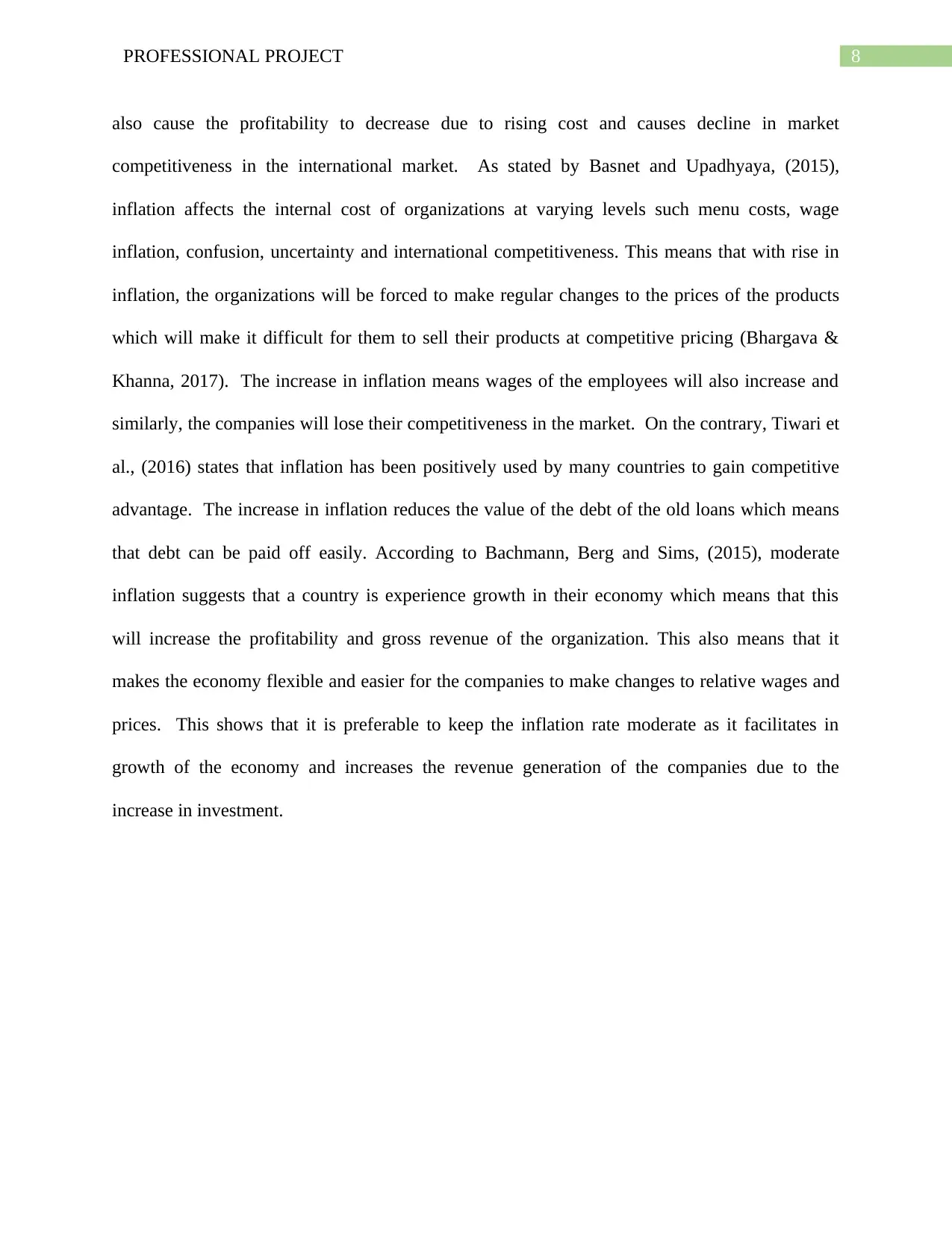
8PROFESSIONAL PROJECT
also cause the profitability to decrease due to rising cost and causes decline in market
competitiveness in the international market. As stated by Basnet and Upadhyaya, (2015),
inflation affects the internal cost of organizations at varying levels such menu costs, wage
inflation, confusion, uncertainty and international competitiveness. This means that with rise in
inflation, the organizations will be forced to make regular changes to the prices of the products
which will make it difficult for them to sell their products at competitive pricing (Bhargava &
Khanna, 2017). The increase in inflation means wages of the employees will also increase and
similarly, the companies will lose their competitiveness in the market. On the contrary, Tiwari et
al., (2016) states that inflation has been positively used by many countries to gain competitive
advantage. The increase in inflation reduces the value of the debt of the old loans which means
that debt can be paid off easily. According to Bachmann, Berg and Sims, (2015), moderate
inflation suggests that a country is experience growth in their economy which means that this
will increase the profitability and gross revenue of the organization. This also means that it
makes the economy flexible and easier for the companies to make changes to relative wages and
prices. This shows that it is preferable to keep the inflation rate moderate as it facilitates in
growth of the economy and increases the revenue generation of the companies due to the
increase in investment.
also cause the profitability to decrease due to rising cost and causes decline in market
competitiveness in the international market. As stated by Basnet and Upadhyaya, (2015),
inflation affects the internal cost of organizations at varying levels such menu costs, wage
inflation, confusion, uncertainty and international competitiveness. This means that with rise in
inflation, the organizations will be forced to make regular changes to the prices of the products
which will make it difficult for them to sell their products at competitive pricing (Bhargava &
Khanna, 2017). The increase in inflation means wages of the employees will also increase and
similarly, the companies will lose their competitiveness in the market. On the contrary, Tiwari et
al., (2016) states that inflation has been positively used by many countries to gain competitive
advantage. The increase in inflation reduces the value of the debt of the old loans which means
that debt can be paid off easily. According to Bachmann, Berg and Sims, (2015), moderate
inflation suggests that a country is experience growth in their economy which means that this
will increase the profitability and gross revenue of the organization. This also means that it
makes the economy flexible and easier for the companies to make changes to relative wages and
prices. This shows that it is preferable to keep the inflation rate moderate as it facilitates in
growth of the economy and increases the revenue generation of the companies due to the
increase in investment.
⊘ This is a preview!⊘
Do you want full access?
Subscribe today to unlock all pages.

Trusted by 1+ million students worldwide

9PROFESSIONAL PROJECT
3.0 Research Methodology
Research methodology is the foundation of the research and illustrates the research
designs, approaches and methods based on the requirement of the study. The goal of the study
will determine the particular methodology to be used and in this study, the main purpose is to
examine the cause and effect relationship between inflation rate and gross revenue generation.
Experimental method has been used to describe the phenomenon and examine the cause and
effect relationship. The explanation method will also facilitate in developing a reliable prediction
from one variable to other variable (Taylor, Bogdan & DeVault, 2015).
3.1 Research philosophy
Research philosophy is concerned with the beliefs and assumption of developing based
on the source and nature of the information gathered. The four different types of research
philosophy used in business research are realism, pragmatism, interpretivism and positivism
(Hughes & Sharrock, 2016). In this current study, positivism has been chosen as the research
philosophy as it will facilitate in observing the phenomenon and conduct quantitative analysis of
data. Positivism also facilitates in highly structured study which leads to observations that are
easily quantifiable and easily analysed. This shows that positivism is more focused on facts and
has no provision for human interest in the study (Quinlan et al., 2019).
3.2 Research Approach
There are three types of approaches to research and they are deductive, inductive and
abductive (Sekaran & Bougie, 2016). The inductive approach is used to develop new theories
and paradigms which is more applicable in phenomenology where a phenomenon is explored. In
deductive approach, specific results are generated from general findings and facilitates testing of
3.0 Research Methodology
Research methodology is the foundation of the research and illustrates the research
designs, approaches and methods based on the requirement of the study. The goal of the study
will determine the particular methodology to be used and in this study, the main purpose is to
examine the cause and effect relationship between inflation rate and gross revenue generation.
Experimental method has been used to describe the phenomenon and examine the cause and
effect relationship. The explanation method will also facilitate in developing a reliable prediction
from one variable to other variable (Taylor, Bogdan & DeVault, 2015).
3.1 Research philosophy
Research philosophy is concerned with the beliefs and assumption of developing based
on the source and nature of the information gathered. The four different types of research
philosophy used in business research are realism, pragmatism, interpretivism and positivism
(Hughes & Sharrock, 2016). In this current study, positivism has been chosen as the research
philosophy as it will facilitate in observing the phenomenon and conduct quantitative analysis of
data. Positivism also facilitates in highly structured study which leads to observations that are
easily quantifiable and easily analysed. This shows that positivism is more focused on facts and
has no provision for human interest in the study (Quinlan et al., 2019).
3.2 Research Approach
There are three types of approaches to research and they are deductive, inductive and
abductive (Sekaran & Bougie, 2016). The inductive approach is used to develop new theories
and paradigms which is more applicable in phenomenology where a phenomenon is explored. In
deductive approach, specific results are generated from general findings and facilitates testing of
Paraphrase This Document
Need a fresh take? Get an instant paraphrase of this document with our AI Paraphraser

10PROFESSIONAL PROJECT
hypothesis. Abductive approach is used to address the shortcomings of the two other approaches
and generally used in mixed method analysis. In this current study, deductive approach has been
chosen as it has facilitated in conducting the hypothesis testing and establishing the relationship
between inflation rate and gross revenue of companies.
3.3 Research Design
There are two types of research design, one is exploratory and the other is conclusive.
The exploratory research design will develop general insights about a situation where the data set
is vague. The inferences that are generated from this types of design are tentative. On the
contrary, conclusive research design uses a set structure and the data sets are properly defined
(Kratochwill, 2015). Conclusive research can be divided into two designs, one is causal and
other is descriptive. In this current study, causal research design has been used to explain the
relationship between inflation rate and gross revenue for various companies in Australia.
3.4 Data Collection and Analysis
There are two types of data collection methods, one is primary and another is secondary.
The secondary data collection method has been used in this study where the data has been
collected from the website of reserve bank of Australia, annual reports of different companies
and other web articles (Lu & Wang, 2017). The study has used SPSS (Statistical Package for the
Social Sciences) as the statistical software to conduct the inferential statistical analysis. The
study had developed the correlation using both parametric and non-parametric correlation
method to identify the nature of relationship between the variables. Similarly, regression analysis
has been conducted to develop a model that will establish the type relationship between inflation
rate and gross revenue.
hypothesis. Abductive approach is used to address the shortcomings of the two other approaches
and generally used in mixed method analysis. In this current study, deductive approach has been
chosen as it has facilitated in conducting the hypothesis testing and establishing the relationship
between inflation rate and gross revenue of companies.
3.3 Research Design
There are two types of research design, one is exploratory and the other is conclusive.
The exploratory research design will develop general insights about a situation where the data set
is vague. The inferences that are generated from this types of design are tentative. On the
contrary, conclusive research design uses a set structure and the data sets are properly defined
(Kratochwill, 2015). Conclusive research can be divided into two designs, one is causal and
other is descriptive. In this current study, causal research design has been used to explain the
relationship between inflation rate and gross revenue for various companies in Australia.
3.4 Data Collection and Analysis
There are two types of data collection methods, one is primary and another is secondary.
The secondary data collection method has been used in this study where the data has been
collected from the website of reserve bank of Australia, annual reports of different companies
and other web articles (Lu & Wang, 2017). The study has used SPSS (Statistical Package for the
Social Sciences) as the statistical software to conduct the inferential statistical analysis. The
study had developed the correlation using both parametric and non-parametric correlation
method to identify the nature of relationship between the variables. Similarly, regression analysis
has been conducted to develop a model that will establish the type relationship between inflation
rate and gross revenue.
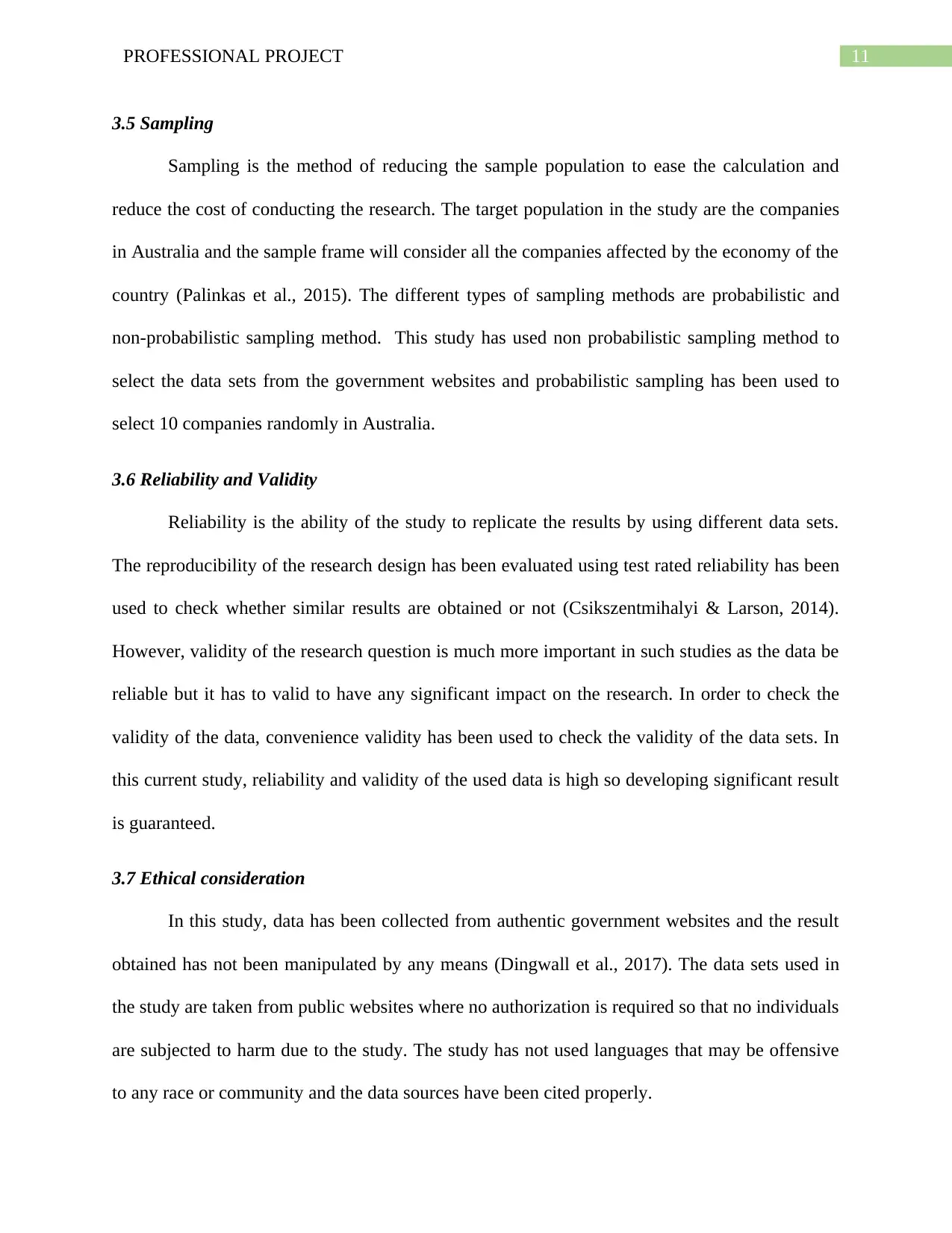
11PROFESSIONAL PROJECT
3.5 Sampling
Sampling is the method of reducing the sample population to ease the calculation and
reduce the cost of conducting the research. The target population in the study are the companies
in Australia and the sample frame will consider all the companies affected by the economy of the
country (Palinkas et al., 2015). The different types of sampling methods are probabilistic and
non-probabilistic sampling method. This study has used non probabilistic sampling method to
select the data sets from the government websites and probabilistic sampling has been used to
select 10 companies randomly in Australia.
3.6 Reliability and Validity
Reliability is the ability of the study to replicate the results by using different data sets.
The reproducibility of the research design has been evaluated using test rated reliability has been
used to check whether similar results are obtained or not (Csikszentmihalyi & Larson, 2014).
However, validity of the research question is much more important in such studies as the data be
reliable but it has to valid to have any significant impact on the research. In order to check the
validity of the data, convenience validity has been used to check the validity of the data sets. In
this current study, reliability and validity of the used data is high so developing significant result
is guaranteed.
3.7 Ethical consideration
In this study, data has been collected from authentic government websites and the result
obtained has not been manipulated by any means (Dingwall et al., 2017). The data sets used in
the study are taken from public websites where no authorization is required so that no individuals
are subjected to harm due to the study. The study has not used languages that may be offensive
to any race or community and the data sources have been cited properly.
3.5 Sampling
Sampling is the method of reducing the sample population to ease the calculation and
reduce the cost of conducting the research. The target population in the study are the companies
in Australia and the sample frame will consider all the companies affected by the economy of the
country (Palinkas et al., 2015). The different types of sampling methods are probabilistic and
non-probabilistic sampling method. This study has used non probabilistic sampling method to
select the data sets from the government websites and probabilistic sampling has been used to
select 10 companies randomly in Australia.
3.6 Reliability and Validity
Reliability is the ability of the study to replicate the results by using different data sets.
The reproducibility of the research design has been evaluated using test rated reliability has been
used to check whether similar results are obtained or not (Csikszentmihalyi & Larson, 2014).
However, validity of the research question is much more important in such studies as the data be
reliable but it has to valid to have any significant impact on the research. In order to check the
validity of the data, convenience validity has been used to check the validity of the data sets. In
this current study, reliability and validity of the used data is high so developing significant result
is guaranteed.
3.7 Ethical consideration
In this study, data has been collected from authentic government websites and the result
obtained has not been manipulated by any means (Dingwall et al., 2017). The data sets used in
the study are taken from public websites where no authorization is required so that no individuals
are subjected to harm due to the study. The study has not used languages that may be offensive
to any race or community and the data sources have been cited properly.
⊘ This is a preview!⊘
Do you want full access?
Subscribe today to unlock all pages.

Trusted by 1+ million students worldwide
1 out of 37
Related Documents
Your All-in-One AI-Powered Toolkit for Academic Success.
+13062052269
info@desklib.com
Available 24*7 on WhatsApp / Email
![[object Object]](/_next/static/media/star-bottom.7253800d.svg)
Unlock your academic potential
Copyright © 2020–2025 A2Z Services. All Rights Reserved. Developed and managed by ZUCOL.





